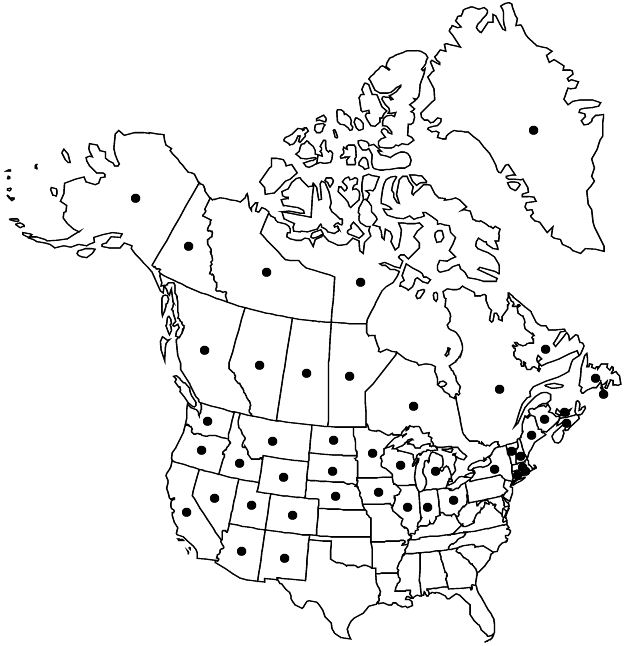Potentilla anserina
Sp. Pl. 1: 495. 1753.
Basal leaves: petiole (0.5–) 1–15 (–25) cm, long hairs absent or sparse to dense, 1.5–3.5 mm; larger leaflets (0.4–) 0.5–5 (–7) × (0.2–) 0.3–2 (–3) cm, surfaces: abaxial with long hairs absent or sparse to abundant, not restricted to veins, 0.5–2 (–2.5) mm, cottony-crisped hairs usually dense or usually absent (in subsp. groenlandica), adaxial with long hairs absent or sparse to abundant, cottony-crisped hairs usually absent, sometimes sparse to common (especially subsp. yukonensis). Flowers: epicalyx bractlets narrowly to broadly ovate-triangular or linear to elliptic, (2–) 2.5–7 (–8) × (0.3–) 0.5–3 (–3.5) mm, often 2-fid or dentate; sepals (3–) 3.5–7 (–9) mm, apex subacute to acuminate; petals (4–) 5–15 (–20) × (2.5–) 3–10 (–12) mm; filaments (1–) 2.5–3.5 (–4.5) mm, anthers 0.7–1.3 mm; carpels (10–) 20–200 (–250). Achenes 2 mm.
Distribution

Alta., B.C., Man., N.B., N.S., N.W.T., Nfld. and Labr., Nunavut, Ont., P.E.I., Que., Sask., Yukon, Alaska, Ariz., Calif., Colo., Conn., Idaho, Ill., Ind., Iowa, Maine, Mass., Mich., Minn., Mont., N.Dak., N.H., N.Mex., N.Y., Nebr., Nev., Ohio, Oreg., R.I., S.Dak., Utah, Vt., Wash., Wis., Wyo., Mexico, South America (Argentina), South America (Chile), Eurasia, Pacific Islands (New Guinea), Pacific Islands (New Zealand), s Australia
Discussion
Subspecies 4 or 5 (4 in the flora).
Potentilla anserina is polymorphic in most features, especially in hairiness, but also in size and in degree of dissection of leaflets, epicalyx bractlets, and sepals. While most of the variation described by A. G. Blytt (1906) is taxonomically insignificant, A. Rousi (1965) found support for three northern races: subspp. anserina, egedei, and pacifica. He also suggested that P. yukonensis Hultén might qualify as a separate subspecies. This treatment follows J. Soják (1994) in accepting four northern subspecies of P. anserina, all present in North America.
A. Rousi (1965) demonstrated partial interfertility between the races of Potentilla anserina, which form intermediates in all zones of contact. The distinctness of the four races, in spite of intermediates, is upheld by being partly allopatric and occupying different habitats where they are sympatric. As partly interfertile parapatric entities, they are best treated as subspecies.
The vast majority of chromosome counts are tetraploid. Tetraploid plants (2n = 28) are fully fertile; hexaploids (2n = 42) are largely pollen and seed sterile; pentaploids (2n = 35) are probably occasional hybrids (S. Erlandsson 1942, 1942b; A. Rousi 1965). A. Kurtto et al. (in J. Jalas et al. 1972+, vol. 13) considered numbers above tetraploid level as cases of occasional autopolyploidy.
Selected References
None.
Lower Taxa
Key
| 1 | Epicalyx bractlets equal to or longer than sepals, often 2-fid or dentate; leaflet surfaces: abaxial with cottony-crisped hairs dense, long hairs common to abundant, on and between veins, adaxial glabrous or sparsely to densely hairy; achenes with dorsal groove; inland and seashore plants | > 2 |
| 1 | Epicalyx bractlets shorter than sepals, usually entire, rarely 2-fid or dentate; leaflet surfaces: abaxial with cottony-crisped hairs absent or sparse to dense, long hairs absent or sparse, on veins, adaxial usually glabrous, rarely sparsely to densely hairy; achenes without dorsal groove; seashore or near-coastal plants | > 3 |
| 2 | Hypanthium patelliform (wider than deep) in fruit; epicalyx bractlets narrowly to broadly ovate-triangular, equal to sepals; most of North America. | Potentilla anserina subsp. anserina |
| 2 | Hypanthium turbinate (± as deep as wide) in fruit; epicalyx bractlets usually linear to elliptic, longer than sepals, rarely subequal; interior w Canada and Alaska. | Potentilla anserina subsp. yukonensis |
| 3 | Carpels (20–)50–200(–250); leaves (3–)10–50(–75) cm; leaflets (4–)5–10(–15) per side, abaxial surfaces densely hairy, teeth (4–)6–12(–16) per side, teeth apices acute to acuminate, rarely subacute; flowers 1–2.5(–3.5) cm diam. | Potentilla anserina subsp. pacifica |
| 3 | Carpels 25–60; leaves (1–)2–10 cm, rarely longer; leaflets 2–4(–5) per side, abaxial surfaces glabrous, sometimes sparsely to densely hairy, teeth 2–6(–10) per side, teeth apices rounded to subacute; flowers 0.8–1.5 cm diam. | Potentilla anserina subsp. groenlandica |
"thin" is not a number."(" is not declared as a valid unit of measurement for this property."dm" is not declared as a valid unit of measurement for this property."dm" is not declared as a valid unit of measurement for this property.